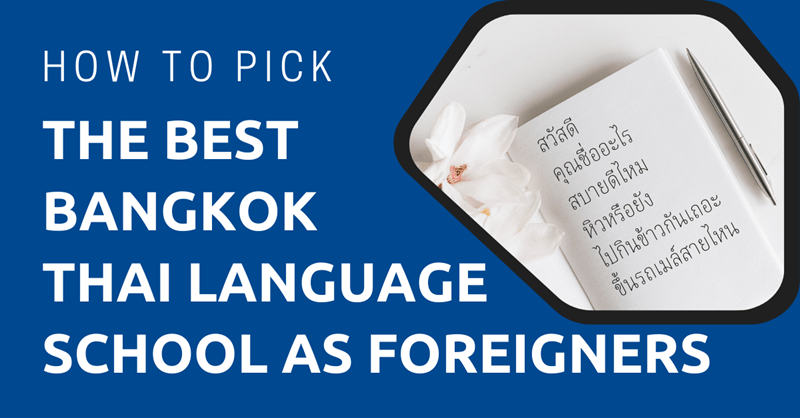
There are many Thai language schools in Bangkok, especially in popular areas like Sukhumvit.
Each school has a different teaching methodology as well as teaching materials. The challenge here is to find a school that suits your language learning style the best.
Since studying Thai in a language school is a popular way to obtain an education visa, there are schools that can help you get an education visa easily. And there are also schools that mainly focus on teaching Thai.
In this article, we are going to guide you through everything you need to know about language schools in Bangkok, so that you can pick the most suitable one for your needs.
Enter your email below to receive our FREE Thai Language Cheat Sheet. It includes a comprehensive list of downloadable PDFs to quickly get you started learning the Thai language. The Cheat Sheet covers everything, from the alphabet, tone marks, and consonant sounds to vocabulary and much more.
Disclaimer: This article may include links to products or services offered by ExpatDen’s partners, which give us commissions when you click on them. Although this may influence how they appear in the text, we only recommend solutions that we would use in your situation. Read more in our Advertising Disclosure.
Contents
Key Takeaways
- Language schools in Bangkok have different teaching methodologies.
- Some may also use their own textbooks.
- There’s no “best” school here; it’s better to find one that works best for you.
- For a group class, you should expect to pay around 8,000 baht for a 60-hour course.
- For a private class, the cost can be around 600 to 800 baht per hour.
- Most schools listed in this article can provide you with an education visa, but you need to attend their classes regularly.
Things to Consider
Through personal observation, I have noticed that getting the best out of a language school is equally about the commitment of the student.
- What’s your goal of learning Thai?
- How much Thai do you want to learn?
- How much time and effort are you willing to give to learning and mastering the Thai language?
- Are you the type of person that follows through on the goals you’ve set for yourself?
All of this plays a massive role in how your Thai language school experience will go and which school you want to select.
For instance, the needs of people that work long hours and the needs of people who have more time in the day are going to be completely different.
For some, the location of the classes is extremely important while others still might focus on getting value for money.
Here are some factors that we think you should look at while assessing and choosing a Thai language school in Bangkok.
Trial Classes
The best way to shop around for Thai schools is to attend a trial class.
Many language schools in Bangkok offer free trial classes in different configurations.
For example, Duke Language School and Sumaa offer a free trial class. You can contact them online to arrange it but some even allow for walk-ins.
I visited Duke Language School to learn more about their curriculum and they asked me if I wanted to attend their trial class.
Within 15 minutes, I was escorted to a free classroom and received a basic lesson from one of their instructors.
Baan Aksorn provides a free Skype lesson after you contact them online.
AUA provides a free trial lesson at the school, but you have to enroll into the school online.
Don’t worry because you can choose to quit the school if you don’t want to commit to their full-fledged program.
When you join a trial class, here’s what you should look at:
- Teacher quality: While the teacher offering a trial class may be different from the one who will actually teach you, it can still give you a good idea of the overall teacher quality at that school.
- Teaching methodology: Do you like the teaching style of the school?
- Study material: Language schools in Bangkok may use various materials. Some may use their own textbooks, while others may use books from Benjawan Poomsan Becker.
- Class size: Some schools limit their class size to a maximum of 5 people, while others can have up to 20 students in their group classes. Generally, smaller is considered better.
- Students: Do the students have good motivation to study? You can also talk with other students, check their Thai fluency, and ask how satisfied they are with the school.
In addition, the trial class is also your opportunity to see other aspects of the school. You can see what your commute will be and how the classrooms look, get your hands on the study materials, and even see how the staff operates.
Meeting the receptionist and the administrative staff and seeing firsthand how they handle your queries, or just taking note of how the common areas of the school are kept, should help you envision what it will be like to study Thai there.
Materials
All schools provide a textbook, which outlines the entire lesson plan that they will follow.

In the past, schools might have provided additional audio CDs or DVDs, but that’s not as common anymore.
Instead, schools have online resources that supplement their student’s appetites to learn and hear more Thai.
The most important things to look out for in a textbook are at the beginning of the book.
Most schools have introductory sections that detail how they use transliteration so that you can read Thai in English script.
Pay attention to how they represent the vowel sounds and tones. Check for sections that explain tone sounds, vowels, and even the alphabet. See if you can get a sense of these concepts early.
You may also find some workbook style exercises for you to practice in each lesson. The better textbooks explain these concepts well and students find these to be helpful.
Also, you can see the contents of your lessons, whether it is about asking for directions, ordering food at the restaurant, and so on.
Some schools provide different books for speaking, reading, and writing. The latter two subjects can be workbooks with exercises that you can practice at home – and that’s a big positive.
While it is important to have a good balance between speaking, reading, and writing Thai, the study materials need to help you progress rather than overwhelm you with information.
If you can leaf through the first lessons on any of these books and feel comfortable with the information, it’s a good sign.
Schools can also supplement these exercises with online resources. Giving you a resource for listening to Thai is a nice bonus, even if there are plenty of YouTube channels that can provide similar content.
Some schools have their own YouTube channels, or they have a blog or a language resource section on their website.
For most schools, the textbook remains their guiding learning resource, and all schools provide this when you sign up for lessons.
Class Sizes
This tends to be a major factor for many students, but they might not realize it right away.
Larger classes of more than 8 people but no more than 15 tend to move slowly but usually spend time on many aspects of each lesson.
This might be frustrating for students that are quick on the uptake and need to move faster.
A typical group lesson in most of these schools is usually between 4 to 8 students.
This is a happy medium for students that are looking to take their time, enjoy a more social setting, and learn from their fellow students. Group activities and class discussion are more fluid in a group this size.
The smallest groups tend to be between 2 and 4 people, but this arrangement is rare to come by as group sizes are the prerogative of the school. It is usually in their interest to make larger groups.
This setting gives students much more one-on-one time with the teacher and it is here that they can ask students all kinds of questions about language or cultural norms.
Prices
In order to estimate the value for money each school offers, it is important to see how each school measures their services.
Some charge fees according to the number of lessons they offer, others count the hours of study provided in each lesson.
Some others charge money by the module. In general, language schools in Bangkok tend to charge around 8,000 baht for a 60-hour course for their group classes, which is basically around 133 baht per hour.
Some may charge more or less depending on how intensive the course is as well as the class size.
Also, you might need to pay around 300 baht to 500 baht additionally for study materials.
Private lessons are more expensive, and they will naturally cost more, whether they are paid per hour or in a package deal. Normally, it’s around 600 baht to 800 baht per hour.
However, it can be worthwhile in terms of value for money, convenience, and language retention.
Based on our observation, the price per hour for language schools in Bangkok isn’t much different.
When it comes to learning a language, it is better to choose the right school that can teach you Thai quickly than trying to find the cheapest one on the market.
It can be more worthwhile in terms of the time you spend and the language fluency you get in return.
Schools, Courses and Teaching Methods
Some schools have their own teaching methods that they believe provide their students with an edge when it comes to learning Thai.
Others follow certain methods that have been tried and tested over the years.
Some schools offer supplementary classes that work on different facets of language learning, while others integrate everything into their courses.
For example, Pro Language has extra conversation classes that students can attend to build up their conversation skills.
In this session, the teacher is more of a moderator that encourages discussion in Thai rather than teaching new concepts. This gives students an opportunity to use their Thai skills in a more forgiving environment.
Schools tend to take the templates of different methods and combine them to form their own approach.
We will discuss these schools in more detail, but first, let’s classify each school according to the method it is most identified with.
Please note that while most of these schools offer an education visa, they are not in the “visa-mill” category, meaning that they offer a legitimate language course, and you are required to study with them regularly each week.
The Union Method
Key Highlights
- It is one of the very first methods to teach Thai to foreigners.
- Initially, the method focuses on spoken Thai before moving on to reading and writing.
- You will learn more about Thai culture and complex sentences in later lessons.
- It’s an effective method but requires a significant time commitment.
One of the first language schools, the Union Language School was established in 1955 and registered with the Ministry of Education in 1965.
As one of the pioneering Thai language schools that had success with teaching foreign students the Thai language, the Union Language School was one of the first schools to have their model imitated and experimented on.
The Union Method begins by focusing entirely on spoken Thai for the first courses of the program.
In this stage, which covers three of their books, teachers read out Thai sentences and students repeat them.
These sentences are arranged as thematic lessons with dialogues between individuals.
Teachers assign students into pairs and they read the dialogues to each other while the teacher goes across the class, listening in and correcting incorrect pronunciation.
Eventually, students move into reading and writing, and they also learn more about Thai culture and more complex conversations in later lessons.
The Union Method requires students to attend at least three hours in a session, and the schedule is set up so students come to study at least five times a week
The Union Method has been one of the first methods to teach Thai to foreigners, and that is why they have many students that have benefited greatly from this system.
It has been copied a lot, and improved upon as well, and it is seen as a good base from a pronunciation standpoint.
The negatives that go against the Union Method are compelling as well. Since it is an older method, subject matter has either aged poorly or is out of touch with modern-day Thai, especially slang.
Refreshed content is key to making the Union Method more engaging and relevant.
Also, the time commitment can be a hindrance to people who cannot go to school every weekday for at least three hours.
The following schools use the Union Method or have incorporated it to a large extent:
Union Language School
- Address: 328 The Church of Christ in Thailand Office Building, 7th floor, Phayathai Road
- How to get there: A 5-minute walk from BTS Ratchathewi Station
- Types of lessons available: Group lessons
- Starting fee: 9,100 baht for a 80-hour group lesson (maximum 10 persons)
- Education visa: Yes
- Read our personal review of Union Language School
- Website
AAA Language School
- Address: 35 Wannasorn Tower, 10th floor, Phayathai Road, Ratchathewi
- How to get there: A 5-minute walk from BTS Phaya Thai Station (Exit 4) or Airport Rail Link Phaya Thai Station
- Types of lessons available: Group, Private, Corporate training
- Starting fee: 7,900 baht for a 60-hour group lesson
- Education visa: Yes
- Read our personal review of AAA Language School
- Website
Rak Thai Language School
- Address: Rak Thai Language School
- 888/104 Mahatun Plaza 10 Fl. Ploenchit Rd. Lumpini Patumwan
- How to get there: A 7-minute walk from BTS Phloen Chit Station
- Types of lessons available: Group
- Starting fee: 7,500 baht for a 60-hour group lesson
- Education visa: Yes
- Read our personal review of Rak Thai Language School
- Website
Benjawan Poomsan Becker’s Phonics
Key highlights
- It’s based on Thai language textbooks from Benjawan Poomsan Becker.
- Language schools may have their own textbooks but still use Benjawan Poomsan Becker’s Phonics.
- It can teach you to pronounce Thai quickly.
- You may still need to study Thai alphabets.
Benjawan Poomsan Becker wrote some of the most influential Thai language textbooks over the past few decades.
Her books, which are published by Paiboon Publishing, contain some of the cornerstone principles of Thai transliteration and phonic representation into English.
As a result, Thai language schools employ this transliteration and some of her language learning techniques into their own textbooks and courses.
Becker’s phonics are a complete system that helps students bridge that difficult gap between reading Thai and letting go of English.
The phonics system allows students to read more complex Thai words aloud without fear of getting the pronunciation and tone wrong as the spelling of Thai words is initially very difficult to navigate.
This means students don’t need to read Thai words in the English language, which has no way of denoting tones or the correct Thai vowel sounds.
And they don’t have to struggle with limited Thai reading skills just to practice speaking the few words that they have learned.
While phonics is certainly helpful, it is by no means a replacement for written Thai itself.
It is a good teaching aid to help people practice Thai initially or read out a conversation, but the fact is, Thai people cannot read transliteration nor are they going to use it in any form in Thailand.
Think of transliteration as a tool in your toolbox rather than the long-term answer to your proficiency needs.
There are many schools that have realized this, and while they might start out with the phonics, you will see them transition into encouraging you to read more Thai as well.
Notable Schools that use Becker’s Phonics:
Baan Aksorn
- Address: House #40 Sukhumvit Soi 33, Klongton Nua, Wattana
- How to get there: A 10-minute walk from BTS Phrom Phong Station
- Types of lessons available: Group, Private
- Starting fee: 16,000 baht for a 40-hour group lesson (4-6 persons)
- Education visa: Yes
- Read our personal review of Baan Aksorn
- Website
Duke Thai Language School
- Address: 10/63, Trendy Building, 3rd floor Sukhumvit Soi 13, Wattana
- How to get there: A 6-minute walk from BTS Asoke Station or MRT Sukhumvit station
- Types of lessons available: Group, Private
- Starting fee: 8,000 baht for a 60-hour group lesson
- Education visa: Yes
- Read our personal review of Duke Thai Language School
- Website
Conversation-Based
Key highlights
- Schools emphasize conversational Thai in different situations.
- After that, they will teach you how to read and write Thai later in the curriculum.
- Some schools may offer separate courses for speaking and writing.
Conversation-based Thai classes are a bit of a misnomer because almost all schools introduce some kind of dialogue or conversation class to help students speak the words aloud.
And everyone provides students with a kind of transliteration system to help them ease into reading Thai.
What makes these schools different from the others we have discussed is the emphasis on conversation as the key to learning the language.
Many schools believe that spoken Thai should be introduced before written Thai.
These schools don’t teach reading and writing Thai until later on in the curriculum.
Other schools believe that reading and writing Thai warrants a different course altogether, which means that you need to enroll into two classes for learning the language at these schools.
Spending more time on spoken Thai is a very practical way to encourage people to learn quickly and use the language in everyday situations.
Learning how to read and write might take away from spending time improving spoken Thai.
Having said that, learning a language certainly entails reading and writing fluently as well.
Another thing to note here is that these schools don’t lean too heavily on any of the established methods we’ve already discussed but they synthesize aspects of each.
For instance, Duke Language School expects students to follow the same schedule as the Union Method (five days a week for at least three hours), but they use different lesson plans and focus on different aspects of conversation rather than more conventional rote-learning.
Jentana and Associates
- Address: 5/8 Sukhumvit Soi 31 Road, Klongtoey-Neua, Wattana, Bangkok 10110
- How to get there: A 10-minute walk from BTS Phrom Phong Station
- Types of lessons available: Private
- Starting fee: 600 baht per hour
- Education visa: No
- Read our personal review of Jentana and Associates
- Website
Sumaa Language and Culture Institute
- Address: Unit 36 Sathorn Soi 1, South Sathorn road
- How to get there: A 10-minute walk from MRT Lumpinee Station
- Types of lessons available: Group, Private
- Starting fee: 33,000 baht for a 60-hour group lesson
- Education visa: No
- Website
Pro Language School
- Address: 10th floor, Times Square Bldg. 246 Sukhumvit Rd
- How to get there: A 3-minute walk from BTS Asoke Station or MRT Sukhumvit Station
- Types of lessons available: Group, Private, Corporate training.
- Starting fee: 5,000 baht for a 30-hour group lesson
- Education visa: Yes
- Read our personal review of Pro Language School
- Website
Automatic Language Growth (ALG)
Key highlights
- Only Thai language will be used in the class.
- You will learn Thai naturally from teachers based on their conversations on various topics.
- It’s a great way to gain confidence in speaking and listening to the Thai language.
- For some, it can be frustrating since you might not be able to understand the lessons completely.
- Only a few schools use this method.
Language learning techniques have been studied for their efficacy, appeal, and consistency for many years now.
These techniques have different approaches and they might benefit students better than some conventional teaching methods. Automatic Language Growth (ALG) is one such method.
Teachers create an environment in which students can only hear Thai. This constant and steady flow of Thai lets students follow along and encourages them to get comfortable listening to the language. It also challenges them to start expressing themselves in Thai.
This method is a great way to jump headlong into the language of Thai and gain the confidence to start speaking the language.
For many students, the “natural” feeling of being able to learn Thai without being judged or switching to English is very beneficial.
For some, the method can seem disorienting and frustrating especially if they cannot interpret the teacher’s lessons effectively.
Others prefer learning language through their grammar and syntax and methodically going through these rules until they can use them effectively.
Not many schools have these defined language learning techniques.
AUA Thai Language Center
- Address: AUA Language Center Head Office 179 Rajdamri Road Lumpini
- How to get there: A 5-minute walk from BTS Rajdamri Station
- Types of lessons available: Group
- Education visa: Yes
- Read our personal review of AUA Thai Language Center
- Website
Private Versus Group Lessons
When you study Thai, you have the choice between taking private lessons or enrolling in group classes.
Private Lessons
It should come as no surprise that private lessons cost more than group lessons. But do you get the value you want from these lessons?
The accepted wisdom is that one-on-one interaction between students and teachers results in a more thorough understanding of the material, especially since the teacher is paying close attention to how the student is learning and retaining the language.
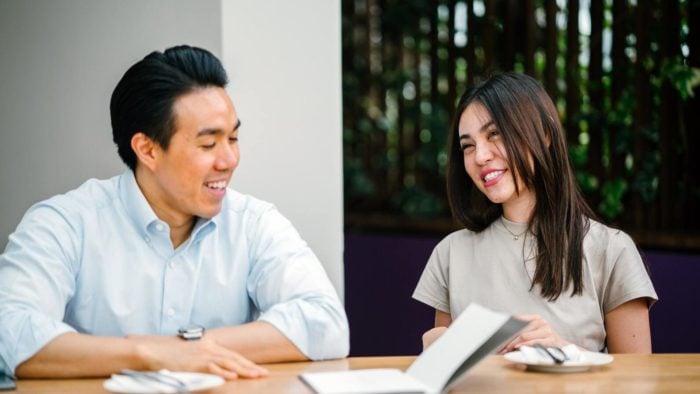
If you feel that you need even more attention to learn the language, then private lessons could well be worth the price.
There are many situations where you need to consider studying Thai privately.
If you have a Thai spouse or child and you need to converse more naturally with them, the one-to-one nature of a private lesson can help improve this a lot.
This is because you spend more time conversing with your teacher in a private lesson than a group lesson, where you might not be called upon to speak as often.
If you have the need to ask plenty of questions and go at your own pace, private lessons are the way to go.
Curiously, fast learners or people that have learned languages well before, might prefer private lessons to get through concepts more quickly.
Specific learning objectives are another case where private lessons can be really helpful.
Examples of this could be learning to read/pronounce names correctly or learning the important terms that deal with the industry in Thailand in which you work in.
As mentioned above, people who have erratic work schedules and need a more flexible schedule could benefit from private classes that can accommodate them.
It’s worth paying extra to keep regular hours to learn Thai rather than to miss lessons for long stretches of time and play catch up.
A good benchmark for private lessons is about 600 baht to 800 baht an hour.
Please note that private lessons by a language school are normally more expensive than a private tutor. However, teachers tend to have more teaching experience and also follow the school’s curriculum.
Group Lessons
Group lessons are much cheaper than private lessons and that is their biggest advantage.
Learning Thai with other people can be fun and you learn a lot from listening to other people trying to speak the language.
Practicing with fellow students and building a sense of camaraderie is very appealing and adds a social element to Thai classes.
However, the flip side could also be the case as certain students could bring the class down with their behavior.
Large groups can be very stifling, and some students might prefer a quicker and more agile learning environment.
Finally, the lack of attention is the biggest drawback. But weighing it up against the cost of private lessons should be the deciding factor.
The folks that can really benefit from a group class are those that have plenty of time to learn Thai.
If you are here on a non-immigrant visa because your spouse works in Bangkok, then a Thai language school is a great way to spend the day productively.
You won’t be allowed to work in Thailand, but you can easily join a Thai language school and put in the hours to learn the language and meet more people.
This can work well for foreign students and folks on a retirement visa as well.
If you are new to Thailand and have set office hours, you can opt for Thai language school and kill two birds with one stone. You will get to learn the language and meet new people as well.
Course Lengths
The average timeline for courses is laid out by the schools themselves.

The other courses differ from school to school, but you can expect the next courses to be the same (60 hours each) or maybe a little longer (90 hours).
Lesson-based courses and modules work out to the same amount of time.
Schools usually have set periods in which you must complete the lessons as well. For example, you might have to attend the 60 hours of classes within 6 months or they won’t carry over.
The most important factor here is the frequency of the classes. Some schools hold classes for students four to five times a week for two or three hours.
The idea here is that the language needs to be explored and practiced on a regular basis.
While this is great for learning the language quickly, as the 60 hours can fly by in as little as a month or five weeks, the issue is that many people cannot find the time to make it for class that often.
The alternative is one or two sessions a week for the same duration, which is common for many schools. This is a lot more convenient but the course does take a lot longer to finish.
For a more goal-oriented approach, here are some estimates for language-learning milestones.
Basic Conversation
Finishing the basic course and proceeding to the next level is a good place to start seeing results. Within three months, it would be possible to do some basic conversation in certain situations such as ordering food at the restaurant, asking questions, and counting.
You’ll learn helpful verbs, nouns, and phrases as well as use cases for these.
Thai phrases for:
- I would like to order a plate of pad Thai noodles, please.
- How much does this cost?
- What time is it?
- Turn left here.
- How are you doing today?
Your teachers will help you understand certain Thai mannerisms and particle words “kha” and “khrap” and monitor your spoken tones to ensure that you aren’t inadvertently saying something else.
Reading and Writing
Reading and writing Thai is difficult for many people due to the various intricacies of the language.
Not only do non-native speakers have to learn a new alphabet, but if they are not accustomed to the tonal system of speaking, then it will be extremely time-consuming to get accustomed to reading Thai.
Reading Thai effectively is much harder than speaking it because the great deal of exceptions and special rules cannot be taught by broad guidelines or rules.
There are many words that simply defy any convention even in Thai. You’ll just have to memorize a lot of these words.
Your Thai reading skills should be proficient enough to help you read public street signs, building names, food menus, and maybe even some children’s fairy tales to begin with.
Keep reading to learn more and expand on your skills to take on more difficult challenges.
With a lot of practice and dedication, it is possible to make serious headway in six months. But for most people, nine months to a year is a more realistic target.
Speaking Fluently
This is much harder to determine and depends on how the individual student takes the lessons from the school and applies it to everyday life in Thailand.
Some people have remarkable commitment and a real need to speak fluent Thai. As a result, these people can initiate conversation and express themselves to some extent in Thai in about 12 to 18 months.
Remember, none of these timelines are guaranteed. You have to put the work in and you will be rewarded with great proficiency in Thai, just like everything else in life.
Education Visa Programs
A very hot topic when it comes to learning Thai in a language school is the role of the Education Visa (ED visa).
Officially, a student must be in Thailand on a non-ED visa for three months and then apply for further extensions to a school that is recognized by the Thai Ministry of Education.
When you apply for the extension visa, your status changes to the ED visa. This extension can be 90 days or six months or even eight months long and if you continue studying Thai.
But it must be extended accordingly with proper documentation from the school.
The student must pay the fees to the school and must spend 15 hours learning Thai every week within the 90-day period.
Some schools have creative ways to count the hours, but it would be in your best interest to attend as many classes as possible.
Schools are very clear about how they manage these ED visas, so do not apply for anything on your own and follow the school’s instructions carefully.
ED visa courses at a Thai language school are sold as packages. The package includes fees for the number of hours you need to study for as well as other fees relating to visa applications.
The lump sum can range from 30,000 baht to 60,000 baht depending on what length of study you have chosen. The visa can be extended to one year in some cases.
You have to appear for the visa extension in person and the visa officer is within their rights to ask you a few basic questions in Thai to see if you are taking your classes seriously.
It might be as simple as:
- Where do you work?
- Where is your house in Thailand?
But it’s a good idea to be prepared for some questions. The 90-day report for residential proof applies as it would for other visa holders, so remember to check-in with your school for this accordingly.
It is always tempting to extend your stay in Thailand with an education visa, but keep attending the classes. If the Immigration Department finds anything irregular in your paperwork from the school, it could lead to deportation.
In the past, language schools have played a role in breaking the law by allowing students to pay for the visa and not attend any classes.
These schools have been blacklisted by the government and if you apply through them, your visa will be most likely be denied outright.
Schools must take attendance and students must attend at least 70% of their classes.
Ask your school if they are recognized by the Ministry of Education for student visa applications. They will have a certificate that verifies this.
Additionally, you can ask if they take attendance and when was the last time they were checked for compliance by the Ministry of Education.
As an Indian citizen, I have inquired about getting a student visa to study Thai but I have been told by the staff of my school that they no longer accept applications for Indian students as their applications get rejected by Thai embassies everywhere.
It is incredibly difficult to provide an exhaustive list of nationalities that have this same issue as these are “unofficial” rules that change quite easily according to the political directives of the Ministry of Education.
But the key takeaway here is don’t make a plan to stay long-term on this visa without checking in with schools first.
Why Learn at a Language School?
At the right language school, teachers can bring the best out of their students.

A great language school can provide all these factors to help you reach your goal of learning Thai.
Not only will the language school save you a lot of time when it comes to organizing and deciding how you need to learn the language, they can also provide an education visa if you choose to learn Thai over a long period of time.
You also forego the hassle of producing your own lesson plan and learning scheme and benefit from expert insight and explanation of cultural nuances that a Thai teacher can bring.
Speaking of which, there are many distinctions between spoken Thai and written Thai as well as everyday Thai used by the locals. It is difficult to sort this out without some guidance by experienced speaker of the language.
Finally, there is the convenience of having an institution to go to rather than holding yourself accountable for every aspect of learning Thai.
Naturally, you need to practice Thai every day in a variety of situations to progress. But the other benefit of going to language school is that you don’t have to do it alone.
I’ve made some good friends at my Thai school after spending more than eight months with more or less the same group of people. Sometimes we go out together and try speaking Thai with mixed results.
Language schools are great places for meeting new friends or looking for business opportunities. And you meet a diverse group of people at a Thai language school and share the same goal of trying to learn Thai.
Now, on to You
It isn’t easy to learn a new language, but a good language school should be able to help.
Learning Thai in a language school will help you improve your skills in a systematic way.
Each school has different teaching methods, courses, and lesson plans. You should find one that matches your own preferred way of learning the most.
In case you don’t have time to attend a school, you can take a look at learning online. It’s another good method to help improve your language skills.






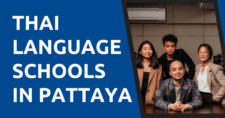
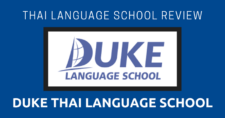
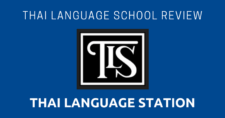
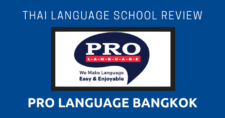
The Thai Embassy here in Canada just confirmed to me that the Thai Ministry of Education (MOE) has no such rule about an upper-age limit for the ED visa. So, both schools (GEOS and PRO) were lying about “following MOE rules”, and GEOS even admitted to me that it’s their internal policy. An internal policy that sets an age-limit for a visa granted by the Thai government sounds like age-based discrimination to me, and is possibly even illegal in Thailand. Since I’m not sure, I have asked the Thai Embassy here to file a report, though I doubt it will go far. I also mentioned all of this in my ongoing messaging with the two schools. They don’t seem too concerned.
Not sure if they are lying about it. Maybe they are not sure about the rules themselves since everyone interpret them differently.
Hi John,
I hope this thread is still active. My understanding is that anyone can study in Thailand with an ED visa, regardless of age. But I just contacted two language schools, GEOS and PRO, and both said they have an upper-age limit for ED visa applicants. Both justified this by saying it was “Ministry rules”. Yet they each gave me a different age limit (50 and 48 respectively). Other Ministry-approved schools like TSL in Chiang Mai (which I know and have previously studied at) clearly state on their website that there is no upper age limit. I am 54.
Something smells fishy. Does it sound to you like arbitrary internal policies designed to discourage foreigners over a certain age to study? Is this “age limit” even legal in Thailand? I am distressed because I was hoping to stay in Thailand for about 1 year on a ED visa.
Thanks for any help you can give!
Chang
Wow, thanks a lot for all the infos!
Are they’re online thai language schools that can provide an ED visa?
Thank you for this very thorough post!